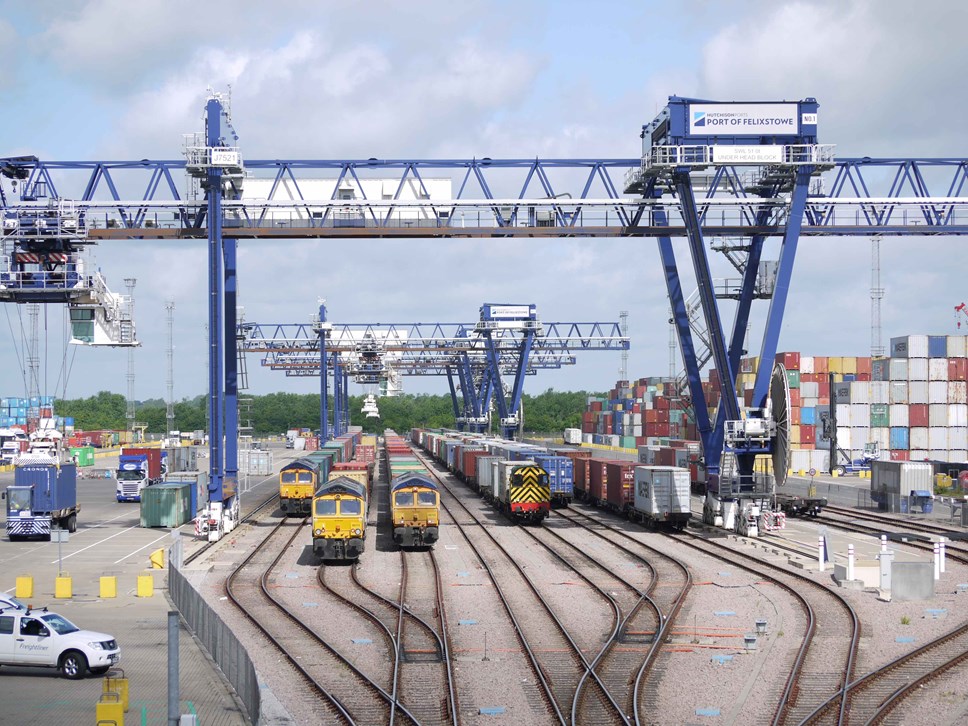
Freight growth target will help unlock demand to move more goods by rail
- Following today’s Government announcement of a rail freight growth target of at least 75% growth by 2050, Great British Railways Transition Team (GBRTT) has published the summary of feedback received in response to a national Call for Evidence.
- The Call for Evidence feedback was used by GBRTT to develop a number of options for Ministers for a rail freight growth target.
- The Call for Evidence revealed there is strong support for a long-term growth target, which will help underpin the decarbonisation of national logistics chains. Respondents felt a target would rally the sector, bringing private and public organisations together, to unlock latent demand.
The Great British Railways Transition Team is today publishing the summary of feedback received to its rail freight growth Call for Evidence.
The Call for Evidence responses were used by GBRTT to inform advice for Ministers for a rail freight growth target. Using the feedback, GBRTT developed an evidence-led analytical framework to produce options for a stretching but realistic target. This advice was presented to the Secretary of State at the end of October.
Rufus Boyd, GBRTT’s Lead Director (interim), said: “We are delighted with the Government’s announcement today for a rail freight growth target of at least 75% growth by 2050. This supports what our customers and stakeholders told us in the national Call for Evidence – that setting a clear ambition for rail freight growth will help bring the sector together, focus minds, break down siloes, and be a catalyst for private investment.
“Rail freight is already a big success story. Moving goods by rail is a greener option and helps cut road congestion, and what we have here is an opportunity to grow rail freight’s modal share. I am convinced that through collaborative working the industry can rise to this challenge, even taking into account the constrained funding environment. I would like to thank everyone who responded to the Call for Evidence for sharing their insights, evidence, and ambitions.”
The advice prepared by GBRTT is the result of close collaborative working with DfT, Network Rail, and the wider industry. It was the first step in ensuring a broad range of stakeholders can help shape and inform future policy on rail freight growth targets in a constructive and transparent way.
Almost 90 responses came from organisations large and small, including those who currently use rail freight and those who don’t currently but have an interest in doing so. Helpful insight was also received from current operators who have a close understanding of how rail freight can thrive in the short, medium and longer term.
The summary report finds there is strong demand to move more goods by rail in the future. Most (86%) respondents said they would like to transfer part of their supply chain to rail. While almost half (44%) said they have facilities, such as quarries, factories and depots, which are adjacent to rail links but currently aren’t connected to the network.
Rail’s green credentials were a big selling point and a catalyst for modal shift. Greater use of rail freight was almost unanimously (97%) seen as a viable solution to reducing emissions from their organisations’ operations.
Usefully, respondents who don’t currently use rail freight described barriers that they felt were hampering organisations from choosing the mode. These included network capacity (18%), cost (17%) and terminal connectivity (17%).
Many respondents also acknowledged that a target alone cannot deliver growth. Further actions and accountability mechanisms will be needed to ensure freight is embedded in the railway’s decision-making processes.
Richard Moody, GBRTT Programme Director, Freight Reform, said: “The 75% rail freight growth target set by the Government is a very welcome first step towards growing rail freight’s modal share. We now need to develop plans and actions with the industry to support the delivery of rail freight growth, embed the target in future funding settlements and decision making, as well as identify and unlock new market opportunities to grow rail freight.
“The responses will continue to be used to inform the industry’s long-term strategies and growth plans. Beyond this, the evidence base will also help to shape and inform future research and activity led by GBRTT.”
GBRTT has established a Strategic Freight Unit (SFU) to bring together expertise from across the sector. To firmly embed freight into rail’s strategic decision making and unlock opportunities for rail freight growth, a guiding mind, capable of making intelligent decisions that optimise the use of the railway network, remains a critical part of much-needed Rail Reform
Notes to editors
- Great British Railways Transition Team is an organisation set up to support creating a simpler and better railway for everyone in Britain
- The call for evidence ran from 5 July to 27 September 2022
- Read the full Call for Evidence summary report: https://gbrtt.co.uk/wp-content/uploads/2023/12/Rail-Freight-Growth-Target-summary-report-v4.7.pdf
- Read the Developing options for a Rail Freight Growth Target to 2050 evidence pack: https://gbrtt.co.uk/wp-content/uploads/2023/12/Developing-options-for-a-Rail-Freight-Growth-Target-to-2050-v1.0.pdf
- Read the Rail Freight Growth Target: Policy Statement on the DfT website: https://www.gov.uk/government/news/government-sets-ambitious-target-to-grow-rail-freight-by-at-least-75
